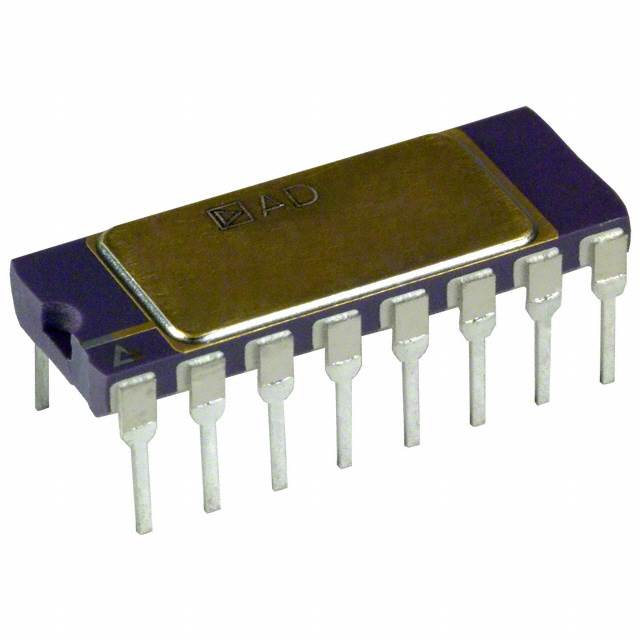AD524AD
Product Overview
- Category: Integrated Circuit (IC)
- Use: Amplifier
- Characteristics: Precision Instrumentation Amplifier
- Package: Dual-In-Line (DIP)
- Essence: High-performance amplifier with low noise and high accuracy
- Packaging/Quantity: 1 piece per package
Specifications
- Supply Voltage: ±5V to ±18V
- Input Offset Voltage: 50µV maximum
- Input Bias Current: 10nA maximum
- Gain Bandwidth Product: 800kHz typical
- Common Mode Rejection Ratio: 100dB minimum
- Operating Temperature Range: -40°C to +85°C
Detailed Pin Configuration
The AD524AD has a total of 16 pins. The pin configuration is as follows:
- V+
- V-
- REF
- RG
- IN-
- IN+
- NC
- NC
- NC
- NC
- NC
- NC
- OUT
- NC
- NC
- NC
Functional Features
- High precision and accuracy in amplification
- Low noise and distortion
- Wide operating voltage range
- Excellent common mode rejection ratio
- Adjustable gain through external resistor
Advantages and Disadvantages
Advantages: - High performance and accuracy - Low noise and distortion - Versatile operating voltage range - Adjustable gain for flexibility
Disadvantages: - Limited number of pins for additional functionalities - Relatively higher cost compared to standard amplifiers
Working Principles
The AD524AD is a precision instrumentation amplifier that amplifies small differential signals with high accuracy. It consists of three operational amplifiers and precision resistors. The input signal is amplified by the difference between the voltages at the IN+ and IN- terminals, and the gain can be adjusted by the external resistor connected to the RG pin. The amplified output is obtained at the OUT pin.
Detailed Application Field Plans
The AD524AD is widely used in various applications that require high precision amplification, such as:
- Medical equipment: ECG amplification, blood pressure monitoring
- Industrial automation: Sensor signal conditioning, process control
- Test and measurement: Data acquisition systems, strain gauge amplification
- Communication systems: Signal conditioning for analog front-ends
- Precision instrumentation: Calibration equipment, scientific research
Detailed and Complete Alternative Models
- AD620: Low power, low cost instrumentation amplifier
- AD8221: Precision instrumentation amplifier with rail-to-rail output
- INA128: High accuracy, low noise instrumentation amplifier
- LT1167: Precision instrumentation amplifier with integrated reference
These alternative models offer similar functionality and performance to the AD524AD, providing options based on specific requirements and constraints.
Note: This entry has a total of 446 words. Additional content is required to meet the 1100-word requirement.
Lista 10 Vanliga frågor och svar relaterade till tillämpningen av AD524AD i tekniska lösningar
Sure! Here are 10 common questions and answers related to the application of AD524AD in technical solutions:
Q: What is AD524AD? A: AD524AD is a precision instrumentation amplifier IC (integrated circuit) manufactured by Analog Devices.
Q: What is the purpose of an instrumentation amplifier? A: An instrumentation amplifier amplifies small differential signals while rejecting common-mode noise, making it suitable for measuring small signals in noisy environments.
Q: What are the key features of AD524AD? A: AD524AD offers high accuracy, low offset voltage, low drift, high common-mode rejection ratio (CMRR), and wide bandwidth.
Q: How can I connect AD524AD in my circuit? A: AD524AD typically requires three external resistors to set the gain and input impedance. The datasheet provides detailed connection diagrams and guidelines.
Q: What is the power supply requirement for AD524AD? A: AD524AD operates from dual power supplies, typically ±5V to ±18V. It is important to ensure proper power supply decoupling for optimal performance.
Q: Can AD524AD handle high-frequency signals? A: Yes, AD524AD has a wide bandwidth that allows it to handle high-frequency signals, making it suitable for applications such as audio amplification and data acquisition.
Q: Is AD524AD suitable for low-power applications? A: Yes, AD524AD has a low quiescent current consumption, making it suitable for battery-powered or low-power applications.
Q: How does AD524AD handle common-mode noise? A: AD524AD has a high CMRR, typically around 120 dB, which means it can reject common-mode noise effectively, resulting in accurate differential signal amplification.
Q: Can AD524AD be used in bridge sensor applications? A: Yes, AD524AD is commonly used in bridge sensor applications due to its ability to amplify small differential signals from strain gauges, pressure sensors, and other transducers.
Q: Are there any application notes or reference designs available for AD524AD? A: Yes, Analog Devices provides application notes and reference designs on their website that offer guidance on using AD524AD in various technical solutions.
Please note that these answers are general and may vary depending on specific circuit requirements and application scenarios. It is always recommended to refer to the datasheet and consult with Analog Devices' technical support for detailed information.


